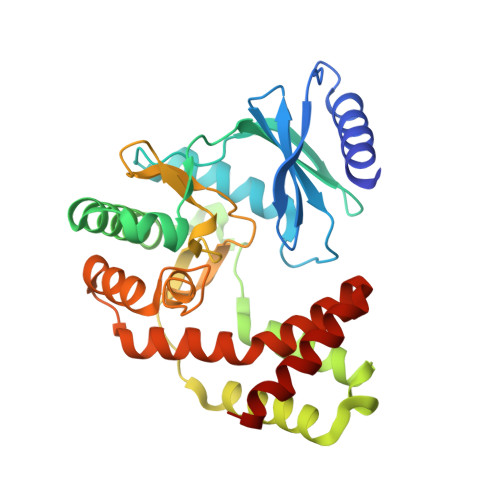Structure of the phosphotransferase domain of the bifunctional aminoglycoside-resistance enzyme AAC(6')-Ie-APH(2'')-Ia.
Smith, C.A., Toth, M., Bhattacharya, M., Frase, H., Vakulenko, S.B.(2014) Acta Crystallogr D Biol Crystallogr 70: 1561-1571
- PubMed: 24914967
- DOI: https://doi.org/10.1107/S1399004714005331
- Primary Citation of Related Structures:
4ORK - PubMed Abstract:
The bifunctional acetyltransferase(6')-Ie-phosphotransferase(2'')-Ia [AAC(6')-Ie-APH(2'')-Ia] is the most important aminoglycoside-resistance enzyme in Gram-positive bacteria, conferring resistance to almost all known aminoglycoside antibiotics in clinical use. Owing to its importance, this enzyme has been the focus of intensive research since its isolation in the mid-1980s but, despite much effort, structural details of AAC(6')-Ie-APH(2'')-Ia have remained elusive. The structure of the Mg2GDP complex of the APH(2'')-Ia domain of the bifunctional enzyme has now been determined at 2.3?? resolution. The structure of APH(2'')-Ia is reminiscent of the structures of other aminoglycoside phosphotransferases, having a two-domain architecture with the nucleotide-binding site located at the junction of the two domains. Unlike the previously characterized APH(2'')-IIa and APH(2'')-IVa enzymes, which are capable of utilizing both ATP and GTP as the phosphate donors, APH(2'')-Ia uses GTP exclusively in the phosphorylation of the aminoglycoside antibiotics, and in this regard closely resembles the GTP-dependent APH(2'')-IIIa enzyme. In APH(2'')-Ia this GTP selectivity is governed by the presence of a `gatekeeper' residue, Tyr100, the side chain of which projects into the active site and effectively blocks access to the adenine-binding template. Mutation of this tyrosine residue to a less bulky phenylalanine provides better access for ATP to the NTP-binding template and converts APH(2'')-Ia into a dual-specificity enzyme.
Organizational Affiliation:
Stanford Synchrotron Radiation Lightsource, Stanford University, Menlo Park, CA 94025, USA.
















